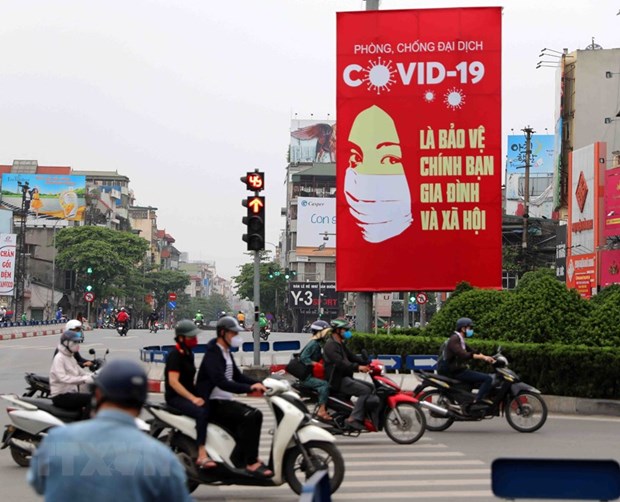 Society
Society

According to the National Steering Committee for COVID-19 Prevention and Control, Việt Nam entered its 68th consecutive day without any community spread of the coronavirus on Tuesday.
According to the National Steering Committee for COVID-19 Prevention and Control, Việt Nam entered its 68th consecutive day without any community spread of the novel coronavirus on Tuesday.
No fatalities have been recorded and 328 patients, or 94 per cent of the total, have been given the all-clear. Among the 349 confirmed cases so far, 209 were imported and quarantined upon arrival.
A total of 7,157 people are under medical monitoring or quarantine, of which 124 people are quarantined at hospitals, 6,159 at medical stations and 874 ones at their accommodations.
Among 21 active patients, three have tested negative for the coronavirus once and three others at least twice.
The country has been hailed by many leading organisations and media across the world for its success in responding to the COVID-19 pandemic, particularly as it shares a long border with China where the virus was first detected.
Việt Nam made preparation to deal with the COVID-19 as early as the very first case in China emerged around mid-December 2019. Prime Minister Nguyễn Xuân Phúc ordered measures to prevent and counter the spread of the disease into the country and to warn Vietnamese citizens to avoid visiting areas with outbreaks.

|
| A poster on a Hà Nội's street calls on people to wear face masks to protect theirselves, their families and community during the COVID-19 pandemic. — VNA/VNS Photo Thanh Tùng |
On January 23, the first two cases of the novel coronavirus were confirmed in Việt Nam. A 66-year-old Chinese man came from China’s Wuhan City to Việt Nam’s Hà Nội to visit his son, who is thought to have contracted the virus from the father when they met in Nha Trang City. They were treated in Chợ Rẫy Hospital, HCM City.
The first cluster of COVID-19 identified in Việt Nam was in Sơn Lôi Commune, Bình Xuyên District in the northern province of Vĩnh Phúc after workers returning from Wuhan tested positive and infected other people.
The Government on February 13 locked down the commune after six cases were discovered there to prevent the disease from spreading.
On February 13, Việt Nam reported its 16th patient of COVID-19. On 25 February, the 16th patient was released from hospital after testing negative.
Việt Nam was clear of the COVID-19 outbreak from February 25 to March 6 until Patient 17 – a woman coming back from Europe, tested positive for the coronavirus. Patient 17 has become known as the case that marked the second wave of the COVID-19 pandemic in Việt Nam.
On March 12, Deputy Minister of Health Nguyễn Thanh Long said Việt Nam would not let the new coronavirus spread freely to create so-called herd immunity. He also confirmed that Việt Nam was able to treat COVID-19 patients and emphasised that, “slowing down the spreading of the virus is the best measure that helps beat the disease successfully.”
At this time, many countries in the world were still following a herd immunity strategy.
On March 18, Prime Minister Nguyễn Xuân Phúc ordered a halt to the issuance of new visas for foreigners entering Việt Nam and limited flights from pandemic-hit zones.
On March 25, Việt Nam suspended all international flights to contain the spread of the virus.
National social distancing orders were implemented from April 1 and lasted until April 23.The orders were lifted in most areas of the country except for some high-risk zones.
The last case of local transmissions was from April16 and the country started to open up as its drastic epidemic control measures generated positive results.
From the experiences gained during the SARS outbreak in 2003, Việt Nam has been proactive in treating COVID-19 patients, with the key method creating a well-ventilated environment, not using air conditioning and regularly disinfecting.
Việt Nam’s health workers are said to have been making miracles, especially with what they have done with Patient 91- a Scottish pilot named Stephen Cameron, the most severe COVID-19 case so far in the country.
He spent 65 days undergoing treatment for COVID-19 at the Hospital for Tropical Diseases in HCM City after he tested positive for the coronavirus on March 18.
On May 22 he was transferred to Chợ Rẫy Hospital for further treatment after testing negative for COVID-19, and at the time was expected to undergo a lung transplant as the disease had reduced his lung capacity to 10 per cent.
He was put on an extracorporeal membrane oxygenation (ECMO) machine and a ventilator, and given many kinds of drugs. Remarkably, on May 26, he showed signs of waking up, communicating and moving after days in a coma.
According to the National Steering Committee for COVID-19 Prevention and Control, the patient is no longer in critical condition and is entering rehabilitation to approach normal health indicators. —VNS




